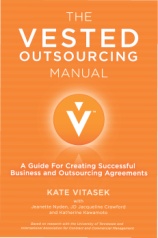Editor’s note: Jeanette Nyden is a frequent contributor to this blog
Have you ever wanted to say no to some unreasonable request, whether from a customer, vendor, boss, or co-worker, but said yes just to keep the peace? If you are like most of us, we are taught that saying no can be a bad thing. But what about those times when you have to say no, and for good reason
Negotiators say no all the time. Negotiators who are skilled at saying no are often the most respected and popular in their field because they are more likely to craft an agreement that meets their needs and their counterpart’s needs too.
Saying no is not as hard as you think. A simple, four-step process gets you there. The set-up for the no—in the form of a counter proposal—is essential.
Four Steps to No
Step 1: Repeat the request in a curious and pleasant tone. It is essential to make sure that you understand what the other person is asking of you. Many of us work off of assumptions causing unneeded stress and confusion.
Here is a simple and effective way to confirm what you are being asked.
- You would like our company to . . . . Am I correct?
Step 2: Ask some clarifying questions.
Clarifying questions are open ended questions meant to get the speaker talking about the reasons behind the request. This is a critical step in the process of saying no. Rather than arguing about the request, learn more about the reasons for the request and use those reasons to make suggestions or to make requests of the other person.
Here are some sample questions that work in any situation. Memorize these so they roll off of your tongue at the right moment.
Tell me more about . . . .
How does that impact . . . .
What concerns you about . . . .
How do you see us accomplishing . . . .
A word of caution about asking questions: Banish the word why from your vocabulary. Why questions put people on the defensive and defensive people are less willing to listen to suggestions or agree to a counter offer.
Step 3: Acknowledge what they have told you with a quick paraphrase. After the other person tells you her reasons for the request, restate those reasons back to her. This step proves to the person making the request that you are really listening to her and understand her objectives. This step sets up the no you are about say, without sounding like you’re saying no.
Good acknowledging statements start with phrases such as:
I see, this change will…
Now I understand. You hope to…
What is most important to you is…
Step 4: Make your counter proposal.
The counter proposal is a soft way to say no. In effect, what you are saying is let’s try something else here. Counter proposals are most effective after you convey your understanding of the reasons behind the request in the first place.
An example of a counter proposal might look like this:
- What if we were to do . . . . . instead?
The key to this step is the word we. You are inviting the other person to join you in creating an alternative that works for both of you.
This four step process invites people to consider alternatives and to work with you to meet their needs, rather than make demands of you. The key to success with this process is to be genuinely curious about the reasons behind the request. The more curious you are the more likely you are to solve their needs.
It is easy to fall into the trap of saying yes to repeated requests just keep the other person happy. But saying yes indiscriminately will cost you a lot of time and money. You can become a skilled negotiator by saying no while at the same time continuing the conversation until you both reach an agreement you can live with.
The next time you are feeling pressured to say yes just to keep someone happy follow these simple steps: Repeat the request to be sure you are hearing them correctly, ask some questions, acknowledge the purpose of the request, and offer your counter proposal. These four steps will give you an agreement that you both can both live with.







